Abstract
Cultivation of ginger, a spicy vegetable, occupies an important position in Japanese agriculture. According to data for 2022, the national ginger harvest was 46.2 kilotons, and the cultivated area was 1.69 thousand hectares. In terms of volume shipped, Kochi has the highest volume of shipments with 16.8 kilotonnes. Past trends show that ginger harvest volumes and cultivated areas have been relatively stable, but there are regional differences in shipping volumes. Kochi in particular is leading in terms of shipping volume, and it can be seen that there are differences in production volumes from region to region. In addition, because ginger is a traditional Japanese seasoning and has medicinal properties, demand for it is stable, providing a steady source of income for farmers.
Ginger harvest yield (main data).
Japan’s ginger harvest has experienced fluctuations between 2002 and 2022. The peak was recorded in 2012 at 54.6 kilotons nationwide, but has since decreased slightly and is currently at 84.6% of the peak level. This trend is due to many factors including changing demand, climatic conditions and advances in agricultural technology. Generally, ginger production is supported by stable demand, but it is true that there are fluctuating factors. What has been seen so far is a slight decline from the peak, but it can still be said that demand and supply remain stable. Farmers are adapting to fluctuations in demand while still producing ginger.
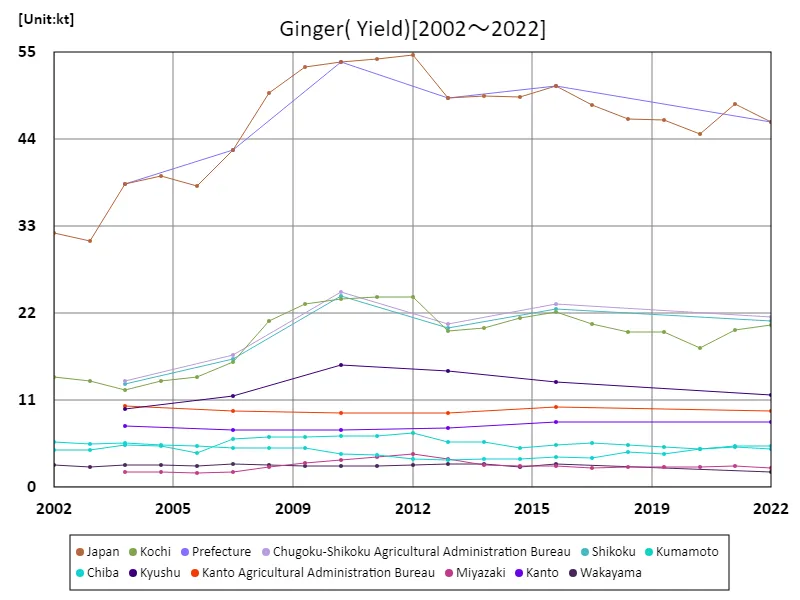

The maximum is 54.6kt[2012] of Japan, and the current value is about 84.6%
Ginger harvest volume (by prefecture).
According to data from 2022, Kochi recorded the highest spicy vegetable harvest of any prefecture in Japan at 20.5 kilotons, which was the highest overall. In light of this latest data, it is clear that Kochi has secured a top position in the production of aromatic vegetables. A notable feature so far has been the tendency for spicy vegetable production to be concentrated in Kochi. Also, since Kochi’s production volume is the highest overall, it can be assumed that the cultivation of spicy vegetables is more active there than in other regions. This may be due to the high demand for spicy vegetables and the fact that Kochi’s climate and soil conditions are suitable for cultivation. This has resulted in significant disparities in production between regions. Spicy vegetables are widely used as seasonings and ingredients, and demand is stable, so producing areas such as Kochi contribute to the local economy.
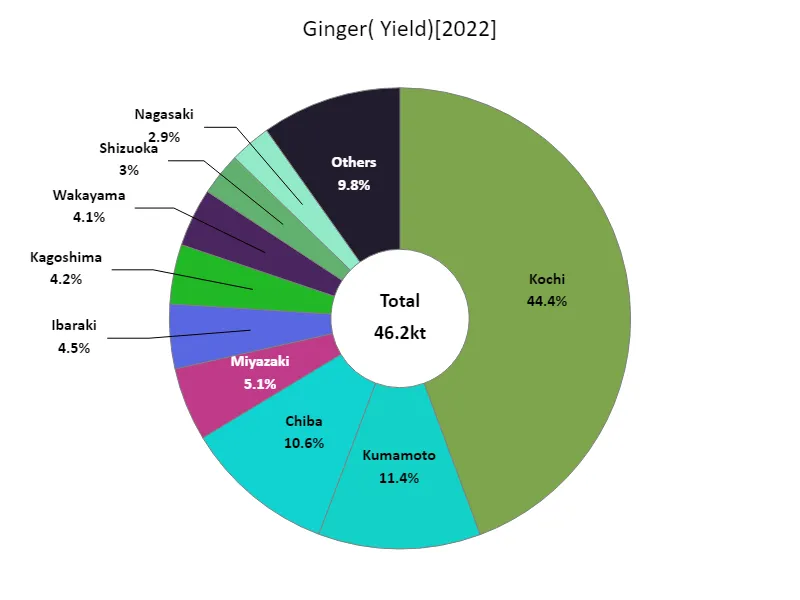

The maximum is 20.5kt of Kochi, the average is 1.05kt, and the total is 46.2kt
Ginger cultivation area (main data).
The area of ginger cultivation in Japanese agriculture has experienced fluctuations between 2002 and 2022. The overall peak was recorded in 2009 at 1,980 hectares, but the current level is 85.4% of the peak. This trend is influenced by agricultural policies, changes in demand, and the economic decisions of producers. Generally, ginger acreage is adjusted according to demand and market changes. Although there has been a slight decline from the peak, there is still stable demand and it is believed that farmers are adjusting production according to demand. In addition, ginger is used as a traditional Japanese seasoning and has medicinal properties, so demand is likely to be stable. What has been noticeable so far is that although there has been a slight decline since the peak, the area planted to ginger has remained at a constant level due to stable demand.
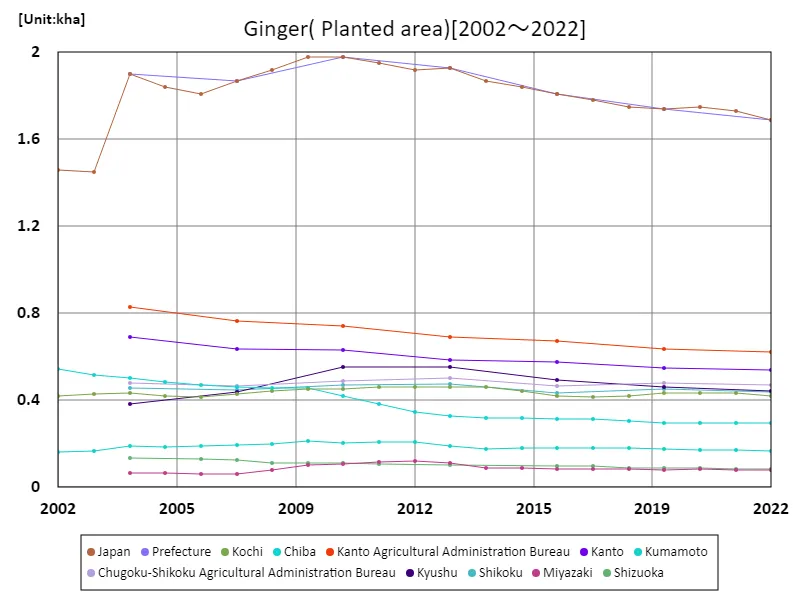

The maximum is 1.98kha[2009] of Japan, and the current value is about 85.4%
Ginger cultivation area (by prefecture).
According to data from 2022, Kochi recorded the highest area of cultivation of spicy vegetables among all prefectures in Japan at 420 hectares, which is also the largest amount overall. In light of this latest data, it is clear that Kochi has secured the top position in terms of area under cultivation of spicy vegetables. A notable feature so far has been the tendency for the cultivation of spicy vegetables to be concentrated in Kochi. Also, since Kochi has the largest cultivated area overall, it can be assumed that cultivation of spicy vegetables is more prevalent there than in other regions. This trend is supported by factors such as Kochi’s climate and soil conditions being suitable for growing spicy vegetables, as well as the technical capabilities of local farmers. Spicy vegetables are an essential ingredient in Japanese food culture, and because demand is stable, producing areas such as Kochi make a significant contribution to the local economy.
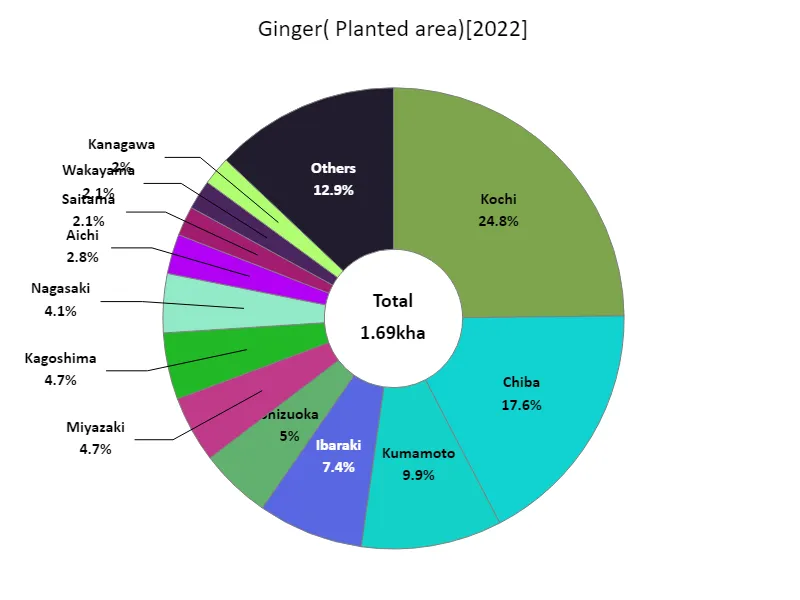

The maximum is 420ha of Kochi, the average is 38.5ha, and the total is 1.69kha
Ginger shipment volume.
According to data for 2022, the overall volume of ginger shipped in Japanese agriculture was highest in Kochi at 16.8 kilotons, with an average of 835 tons and a total of 36.8 kilotons. Given this data, it is clear that Kochi holds the top position in terms of ginger shipments. In general, ginger shipping volumes are affected by the characteristics of the producing region and fluctuations in demand. Kochi’s warm climate and fertile soil are ideal for cultivating ginger, which is thought to be one of the reasons why the region’s shipping volume exceeds that of other regions. Additionally, ginger is a seasoning that is widely used in Japanese cuisine, and the constant demand for it also contributes to the stability of shipping volumes. On the other hand, shipping volumes from other regions are lower than Kochi’s, resulting in differences in production and shipping volumes between regions. Ginger shipments vary between regions due to fluctuations in demand and weather conditions, but overall, stable demand supports ginger shipments.
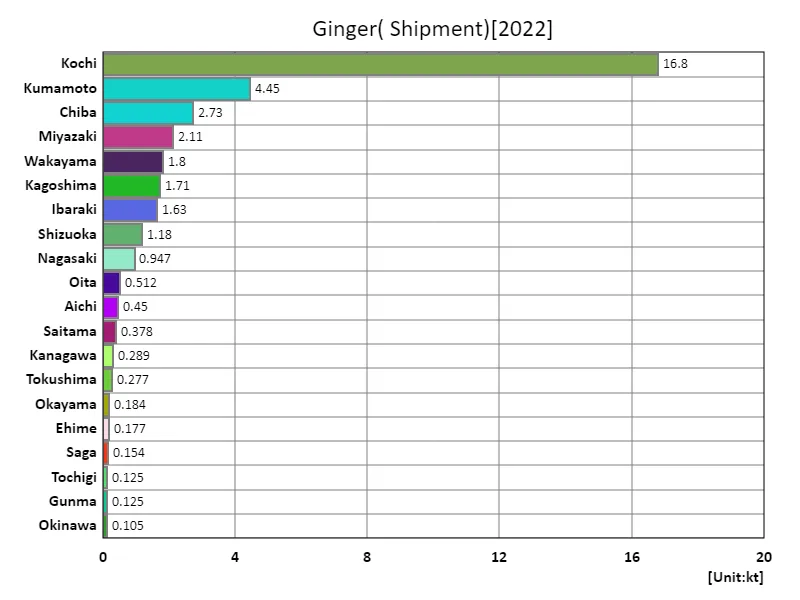

The maximum is 16.8kt of Kochi, the average is 835t, and the total is 36.8kt



Comments